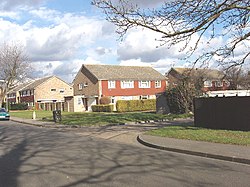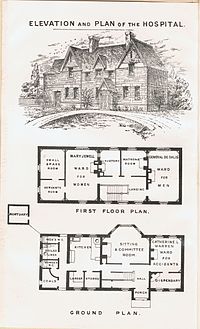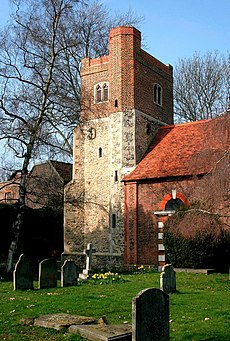Cranford, Middlesex
| Cranford | |
| Middlesex | |
|---|---|
 Hither Moor Road | |
| Location | |
| Grid reference: | TQ105765 |
| Location: | 51°28’36"N, 0°24’28"W |
| Data | |
| Post town: | Hounslow |
| Postcode: | TW4, TW5 |
| Dialling code: | 020 |
| Local Government | |
| Council: | Hounslow |
Cranford is a village in south-western Middlesex, within the Elthorne Hundred, caught within the edges of the conurbation on the eastern perimeter of Heathrow Airport.
The area is bounded in the west by the airport and the River Crane which flows through publicly owned Cranford Park. To the north the village is bounded by the M4 motorway.
Cranford "was described for centuries as one of the smallest and prettiest villages in Middlesex".[1] That was before the encroachment of the urban sprawl.
The name of the village is from the Old English cran-ford,meaning 'crane ford' (in which 'crane' may be the bird known by that name today or a heron).[2][3]
Contents
History
Before the Norman Conquest, the village was a small village completely surrounded by its open fields abutting the north of Hounslow Heath.[4] The Domesday Book of 1086 records the manor of Cranford being given to a Norman baron, William Fitz Ansulf. By the 13th century, the main area of Cranford Park and House, the High Street and Bath Road had been given to the Knights Templar, who were succeeded by the Knights Hospitaller, or Knights of St John of Jerusalem, when the templars were suppressed. The latter order gave this manor its title 'Cranforde St John'. The rest of the village comprised a manor known as 'Cranford le Mote', which included the manor house and stretched in a narrow taper to the north of the present M4 motorway.
The manors were reunited by purchase by Sir Roger Aston, an official to the King, 64 years after the Dissolution of the Monasteries and were bought by Sir Thomas Berkeley's widow Elizabeth in 1618. These stayed in the Berkeley family, who granted smallholdings over this period, until selling the house and Cranford Park to the local council in 1932, which sold them on to Middlesex County Council in 1935.
There was a ford to the north of the church on Watersplash Lane, but the main crossing was where the bridge replaced it on the Bath Road (the A4). The river was widened, probably in the 18th century, on either side of the Church Road to form two ornamental lakes. By 1820 there were at least four large ponds, three of which lay in the village on the edge of the common on the Southall Road. The fourth lay immediately east of the moat. By 1958 these had all been drained.[2]
The Parkway was built in 1959 as a bypass and this became a link to the M4 motorway built in 1960-1964, cutting through the north end of the area. Both had considerable impact on the area. Much of Heston was developed in the early 1930s and this extended westward towards Cranford later, which also became developed to the west and south of the Parkway. The Parkway has cut Cranford in two, severing the high street into two sections, and along many sections there is not even a pavement for pedestrians though instead a green footpath alongside an inter-London trunk route.
The Cranford Agreement
The middle of the locality's position, directly below the flight path of the northern runway of Heathrow Airport led to a ministerial statement-backed undertaking by the airport operator: the Cranford Agreement given on 31 July 1952 at a meeting of the Cranford Residents' and District Amenities Association — as far as possible, the northern runway would not be used for landings or take-offs to the east. This meant that houses under the flight path would not have to suffer the noise from landings, and more especially, louder take-offs.
This was gradually watered down to a limited number of flights with government agreement. A study in an air transport white paper of December 2003 proposed that, since an additional runway at Heathrow could not come into operation before at least 2015–2020, further consideration ought to be given to the scope for using the two existing runways more; for example, through mixed-mode operations. Various runway operations in the 2010s decade have permitted this, with most operational hours compliant with the agreement as it stands which prohibits night flights and specifies the maximum number of flights a day over Cranford which is a restricted minority of flights.
Churches
There are three noted churches in the village:
- Church of England:
- St Dunstan
- Holy Angels (1970)
- Roman Catholic: Our Lady and St Christopher
St Dunstan's Church stands in Cranford Park, adjacent to the stable block of Cranford House. The oldest surviving part is its 15th-century tower. There was a priest at Cranford in 1086, when he held 1 virgate of land, so the Victoria County History states there was presumably a church. The benefice us a 'rectory', meaning that no secular church tithe appropriation ever took place, and the priest in charge is a 'rector', not a 'vicar'. The advowson, which is to say the right to appoint the priest, was held for over a century in the Middle Ages by two religious orders, the Knights Templar and the Knights Hospitaller.[5] The tower and the nave survived a fire in 1710, and the repairs were paid for by Elizabeth, Dowager Countess of Berkeley in 1716.
Notable monuments in the church include a large wall monument to Sir Roger Aston (d. 1612) and his wife Mary (d. 1606), sculpted by William Cure I; another to Elizabeth, Lady Berkeley (d. 1635), with a marble effigy by Nicholas Stone; and a mural tablet to Thomas Fuller (d. 1661), author of the Worthies of England, who was rector of Cranford.
The oldest bell in the church was cast in 1338 and is said to have chimed on every occasion of national importance since.[5] One of Cranford's residents was the Member of Parliament and writer (George Charles) Grantley (Fitzhardinge) Berkeley (d.1881), known for his violent behaviour. His brother, Earl Fitzhardinge, was the patron of the church, although convicted for criminal conversation (adultery): he died unmarried and without legitimate children.[3]
Holy Angels was built in 1970, but is the third Holy Angels church in the town. The first, a corrugated iron mission hut, was built by Maurice Child in 1935. It was on the site now occupied by Tesco Express on Bath Road. It burnt down in 1941 and was replaced a year later by a converted Rodney hut. This second building burnt down in 1965. The current building, in Cranford High Street, was opened by Mary Lalle Foley-Berkeley, 17th Baroness Berkeley and the suffragan Bishop of Kensington, on 26 September 1970.[6]
About the village
The village still has some distinguished houses, including Stansfield House, a 17th-century listed building.[1]
Cranford also has one of only two remaining "lock-ups" in Middlesex, this one built in 1838 to hold drunks and vagrants overnight, before finding use as a mortuary for the parish council.
The Berkeley family also gave their name to Berkeley Parade, where there are now many shops, largely convenience or regular services, which were built on remaining common land open fields on the south of the Bath Road in the 1930s – the "château-type" buildings with little slated turrets were branded "ingenious architectural fun" in the journal Architectural Review in 1939.
Outside links
| ("Wikimedia Commons" has material about Cranford, Middlesex) |
References
- ↑ 1.0 1.1 Hounslow LBC Plan
- ↑ 2.0 2.1 Cranford: Introduction – A History of the County of Middlesex - Volume 3 : {{{2}}} (Victoria County History)
- ↑ 3.0 3.1 'Coxlodge - Cranham' – Lewis, Samuel: 'A Topographical Dictionary of England' (S. Lewis and Co., 1848) p713-717 ISBN 978-0-8063-1508-9
- ↑ Map of the 14 to 16 parishes in Elthorne 1066 to the 19th century – A History of the County of Middlesex - Volume 3 : {{{2}}} (Victoria County History)
- ↑ 5.0 5.1 Cranford: Churches – A History of the County of Middlesex - Volume 3 : {{{2}}} (Victoria County History)
- ↑ The Parish of Cranford: St Dunstan with Holy Angels

